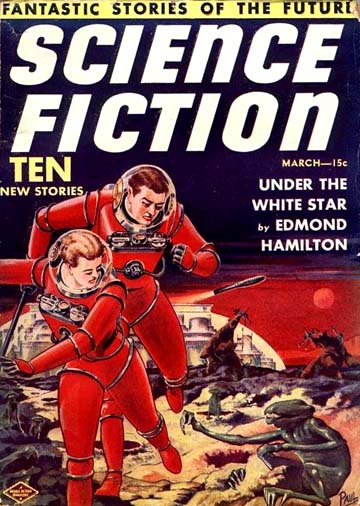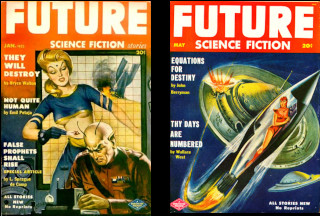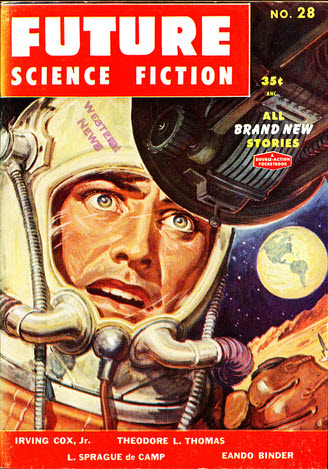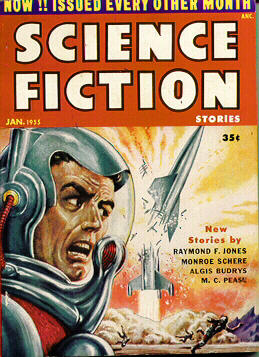 Back in March* of 1939, just a few months before the first ever World Science Fiction convention would be held at Caravan Hall in New York city, a new SF magazine was released to the newsstands.
Back in March* of 1939, just a few months before the first ever World Science Fiction convention would be held at Caravan Hall in New York city, a new SF magazine was released to the newsstands.
It had the distinction of being the first magazine to carry the name of the genre itself – Science Fiction.
It would soon be joined by two other titles from the same publishing firm, Blue Ribbon magazines: Future Fiction in November of the same year and a few months after that, Science Fiction Quarterly. Science Fiction and Future Fiction would go on to have one of the more complex publishing histories of any of the pulp magazines, but a bit more about that in a moment.
 All of those titles were edited by one Charles D. Hornig, a fan who, at the age of 17 had been hired, on the strength of his fanzine editorializing, by Hugo Gernsback, to edit Hugo’s Wonder Stories titles, who would move on to Blue Ribbon following the sale of Wonder Stories to the Thrilling Group in 1936 (and hence the title change to that magazine, making it Thrilling Wonder Stories).
All of those titles were edited by one Charles D. Hornig, a fan who, at the age of 17 had been hired, on the strength of his fanzine editorializing, by Hugo Gernsback, to edit Hugo’s Wonder Stories titles, who would move on to Blue Ribbon following the sale of Wonder Stories to the Thrilling Group in 1936 (and hence the title change to that magazine, making it Thrilling Wonder Stories).
(If you have gotten the impression that you have run up against a bit of science fiction pulp magazine history, you would not be mistaken.)
It’s not un-reasonable to assume that Charles brought and distributed a bunch of copies of the new magazine to that convention, which makes it very likely that most of the attendees were able to read the contents, which included an introduction cum editorial from none other than Hugo Gernsback himself.
This of itself was unusual as Hugo could be considered a “competitor” in some respects, though it is very likely that Charles simply asked his editorial mentor for some help in boosting the appeal of the new rag.
This was, and remains a prediction that should resonate with all fans of the genre. After reading it, we hope that you’ll stick around for the additional discourse on science fiction pulp magazines that follows. So without further ado we give you –
“Science Fiction”
by Hugo Gernsback
WHEN I coined the term “science-fiction” way back in 1926 in the first science-fiction magazine (Amazing Stories) which was published by me at that time, I perhaps did not fully realize what I had let loose on an unsuspecting and unprepared world.
While science-fiction has had its ups and downs, lately it has taken a remarkable upswing and the end is not in sight. It would seem that the younger generation, in particular, is beginning to take science-fiction more seriously than ever before, which is as it should be; because, after all, science-fiction is a great stimulus to the imagination, and particularly to the younger people who refuse to believe that space navigation and death rays are an impossibility, as maintained by many scientists today.
Then too, science-fiction has received a tremendous stimulus via the comic strips where, for a number of years, science-fiction has held forth triumphantly. On top of all this, the radio has done a great deal to popularize science-fiction and, adding up all the factors, it would seem that this type of literature is in for the universal popularization which, as I have always maintained in my former writings, it should command.
The possibilities of science-fiction are quite endless. When I conceived the first science-fiction monthly, there was no science-fiction on the air, nor in cartoons and movies; all of these have come later and have proven a tremendous boost to this type of fiction. What new forces there will be added during the next ten years to come, to further popularize it, is difficult to predict. There is no question, however, that science-fiction has come to stay and that it will keep going at a tremendous rate from now on.
The mere fact that, today, there are more magazines of this type than ever before is a very healthy sign and augurs well for the future of this type of literature.
While 1 have been somewhat distressed to note that some of the magazines have departed from the science-fiction type of story, and gone in almost wholly for the “fairy-tale” type of fiction instead, I believe this will remedy itself in due time.
So many new things are happening in science every day that there Is really no excuse for going into the “Alice-in-Wonderland” type of fiction.
For this reason I am particularly well pleased that the publishers of this new magazine have chosen the name of “Science Fiction,” which I originally coined, and I believe they are to be congratulated upon their wisdom in the selection of this title. I predict that the magazine will have a long life and, with good old artist Paul back on the job to give you the brilliant drawings and covers you want, there is no reason why SCIENCE FICTION Magazine should not have a brilliant future.
1939 was some 83 years ago. There was no television. Radio was beginning to come into its own as a medium. Film had recently introduced synchronized sound a bit over a decade before, and Superman was nowhere near a household name. Most in attendance at the Worldcon who might have read this editorial would not yet have seen the introduction of color to feature length films and yet, here is Gernsback predicting that the science fiction genre would come to dominate those media, as well as others that were not yet within the public’s sphere of experience (Gernsback would conduct some of the world’s first television broadcasts from his offices in the Empire State Building) and yet. here he is predicting that the science fiction genre would come to dominate. And it has!
Oh, it may not all be the kind of SF we’d like to see and yes, it is a bit heavy on the superhero adjacency side of things, but on the other hand, the Chinese government has identified the genre as an instrument for social change and over in the West, a significant portion of the top-rated AND top grossing fare are of an SFnal nature.
A few years later, A.E. van Vogt would clue us in to the fact that all Fans are Slans, but a bit before that, good ol’ Hugo identified the landscape that those Slans would inhabit.
Be careful what you wish for?
And now, the actual article you’ve all been waiting for –
An opportunity to discuss the pulps and their collecting rarely comes along and I intend to take full advantage of that opportunity.
I collect Volume one Number One (V1N1) issues of the English language science fiction and fantasy magazines.
I’ve got quite an extensive collection that grows when opportunity and budget permit and I was recently reminded of the tortured history of the magazine titled Science Fiction by the availability of one of the titles in its history that qualifies for my collection.
V1N1s are not just the very first issue of a magazine, (in fact, sometimes they are even numbered “Volume 0”) as I also include issues that may be the resumption of a title following a hiatus, a major change of title or the reintroduction of a title following a discontinuation.
For example – Science Fiction and Future Fiction. On first blush, you’d assume two issues – Science Fiction V1N1 and Future Fiction V1N1 – would be the entries in the collection for those titles when, in fact, in order to properly represent them, you’d have to have eight different issues (not counting “foreign” editions) in your collection.
This is because the title was resurrected, combined and/or changed title significantly that many times in its history.
It’s actually more complicated than that, but this is just meant to be a brief aside that allows me to write about one of my favorite subjects AND announce that, with the exception of a single title, I now have copies of all of the issues of this title (“completion” being a “thing” for magazine collectors).
 Soon after Future Fiction was introduced, the publisher decided to combine both titles into Future Combined with Science Fiction.
Soon after Future Fiction was introduced, the publisher decided to combine both titles into Future Combined with Science Fiction.
 The title went into a brief hiatus during WWII and, when it re-emerged, it carried the title of Future Combined with Science Fiction Stories (a “resumption” AND a (slight) title change.
The title went into a brief hiatus during WWII and, when it re-emerged, it carried the title of Future Combined with Science Fiction Stories (a “resumption” AND a (slight) title change.
That title would itself experience two additional title changes during its run – Future Science Fiction Stories (January 1952) and Future Science Fiction (May, 1952). 
In 1953, Science Fiction was again separated from Future for two “test” issues under its own name.  This test proved that a digest sized magazine could be successful, with the upshot that Science Fiction Stories (not Future Fiction) would be continued as a digest.
This test proved that a digest sized magazine could be successful, with the upshot that Science Fiction Stories (not Future Fiction) would be continued as a digest.
However, not too long after that, Future itself was once again re-issued with its own numbering.
 Finally, in late 1955, the name of Science Fiction Stories had the phrase “The Original” added to it, a reference to the fact that the title was descended from that first issue in 1939, and NOT intended as a new title. The upshot of that change was that many people to this day are unaware of the connection to the first magazine to carry the title of Science Fiction and believe that there was once a pulp magazine named “The Original Science Fiction Stories”.
Finally, in late 1955, the name of Science Fiction Stories had the phrase “The Original” added to it, a reference to the fact that the title was descended from that first issue in 1939, and NOT intended as a new title. The upshot of that change was that many people to this day are unaware of the connection to the first magazine to carry the title of Science Fiction and believe that there was once a pulp magazine named “The Original Science Fiction Stories”.

*The cover date on magazines was originally not meant to indicate the date of issue, but rather the date that a particular issue was to be removed from the newsstands, to be replaced by the next issue. Thus, Amazing Stories, with a cover date of April, 1926, is known to have actually been distributed on March 10th of that year. Similarly, Science Fiction was probably made available at the beginning of February of that same year.
**Please note that we are still having some back-end issues with the website. At the present time, that issue is causing the post’s featured image to appear at the beginning of the post unintentionally.










